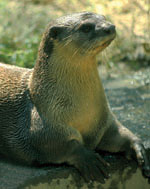 |
|
 |
|
|

Otters are small, semi-aquatic mammals, related to minks, also killed for their fur. All three species of otters/ud-bilao/pani-ka-kutta/jal-mansya (water- cat, dog or man) found in India are protected wildlife, but are poached by the very same people who trap, kill, transport, smuggle out and sell tigers and leopards.
About 20-30% of wild animal furs seized in the north, are those of otters. Frequent arrests are made and otter pelts and iron traps seized, but tenfold go scot-free. Said to be smuggled out in petrol tanks, the skins reach the illegal fur markets of Tibet and China. No wonder 50% of the world’s otter skins originate in India. And, widespread online trade has added to worsening the situation considerably.
Otter fur is considered high quality because of its luxurious thickness (650,000 hairs per square inch) and is used to make coats, jackets, scarves and handbags. It is said that the best waterproof otter skins are from India and Pakistan. Their denseness is meant to act as insulation for otters living in chilly waters. |
Survival at Stake
|
|
Otter pelts are smuggled out of the country, whereas otter genitals, skulls and other body-parts are ground up and used as ingredients of traditional medicines within India. Otter oil is sold as a cure for joint pains and pneumonia. About 250 grams of oil can be extracted from the fat of one otter and it fetches no more than a few hundred rupees. Obviously why, otters do not survive outside protected areas.
However, otters are supposed to be found all over the country from Kashmir to Kerala. Development projects such as dams like on the river Chambal in the 1950s adversely affected their population around the Kota Barrage in Rajasthan and the Gandhi Sagar dam in Madhya Pradesh (where they resurfaced in the 1990s). By 1965 they had almost disappeared from Kota and Rawatbhata. Aquaculture, and illegal mining, wood felling and fishing have harmed them, and the loss of their wetland habitats due to pesticides and industrial pollution, is as much responsible as poaching, for their decline in numbers.
Otters are carnivorous and feed on fish and other aquatic creatures. Smooth coated otters help fishermen by chasing schools of fish into fishing nets. Called Otter Fishing it is a traditional method in Bangladesh where they even breed otters to train them to chase fish. |
Poaching and Smuggling
|
|
Networks of poachers and illegal traders operate in all the protected mangrove areas. After locating otter footprints, poachers set leg-hold traps on riverbanks and deftly disguise them with sand.
Otters are also hunted with the help of tribes using hounds or dogs trained to corner them. Interestingly, the nomadic Bagiri tribe that hail from Haryana who are experts at hunting otters, and who surprisingly go all over the country to find them, also worship them!
Luckily, the Dalai Lama does not approve of the traditional Tibetan dresses called chuba being embellished with otter skins or any other endangered furs.
98% otters are said to be poached for their skins. Nepal and Bangladesh are the countries through which smuggled otter pelts travel to reach international fur markets. It is quite possible that the enthusiasm to catch smugglers of tiger body-parts, has led to the pelts of otters being overlooked.
In June 2011, BWC wrote to the Union Minister for Home Affairs to help by firmly cracking down on smugglers at the borders. But, poaching and smuggling continues. For instance, in April 2014 an otter skin was seized from the forests of Baikunthapur. It was being smuggled to China via Nepal along with skin and bones of a leopard.
Traffic India found that illegal otter trade apart, of the 167 otter seizures (around 6,000 otters) in South & South East Asia between 1980 and 2015, 53% were of India.
By the end of 2018 keeping “cute” otters as pets was becoming popular, particularly in Japan where an otter pup fetched $10,000 and otter cafés (like cat and dog cafés) were growing in number. Thus poaching and smuggling them was on the rise. Small clawed otters are favoured as pets, whereas the smooth-coated otters are killed for their pelts. Poaching is responsible but habitat loss is also responsible for their decline because mothers are killed not only for their skins, but in order to capture their new born pups.
The Nityata River Otter Conservancy that protects otters and their habitat in the Cauery River and its tributaries rightly feels that otters deserve attention because they are indicators of the health of a riverine ecosystem which plays as crucial a part in maintaining the ecological balance of forests.
BWC was therefore pleased when in August 2019 the United Nations’ Convention on International Trade in Endangered Species (CITES) at their meeting in Geneva voted to ban international trade in smooth-coated and small-clawed otters both found in India, especially in the Konkan.
|
|
| Page last updated on 08/04/24 |
|
|
 |
|
 |
|
|